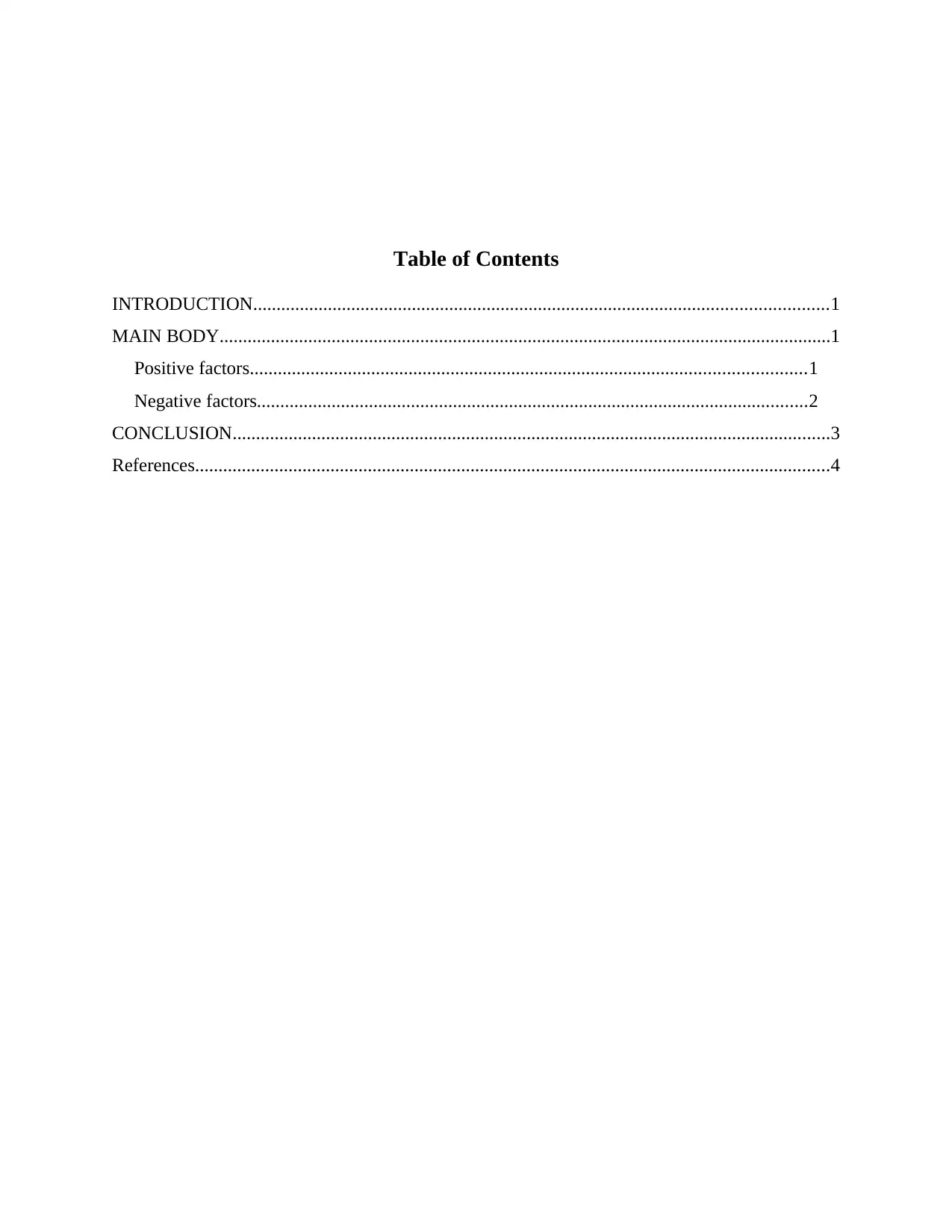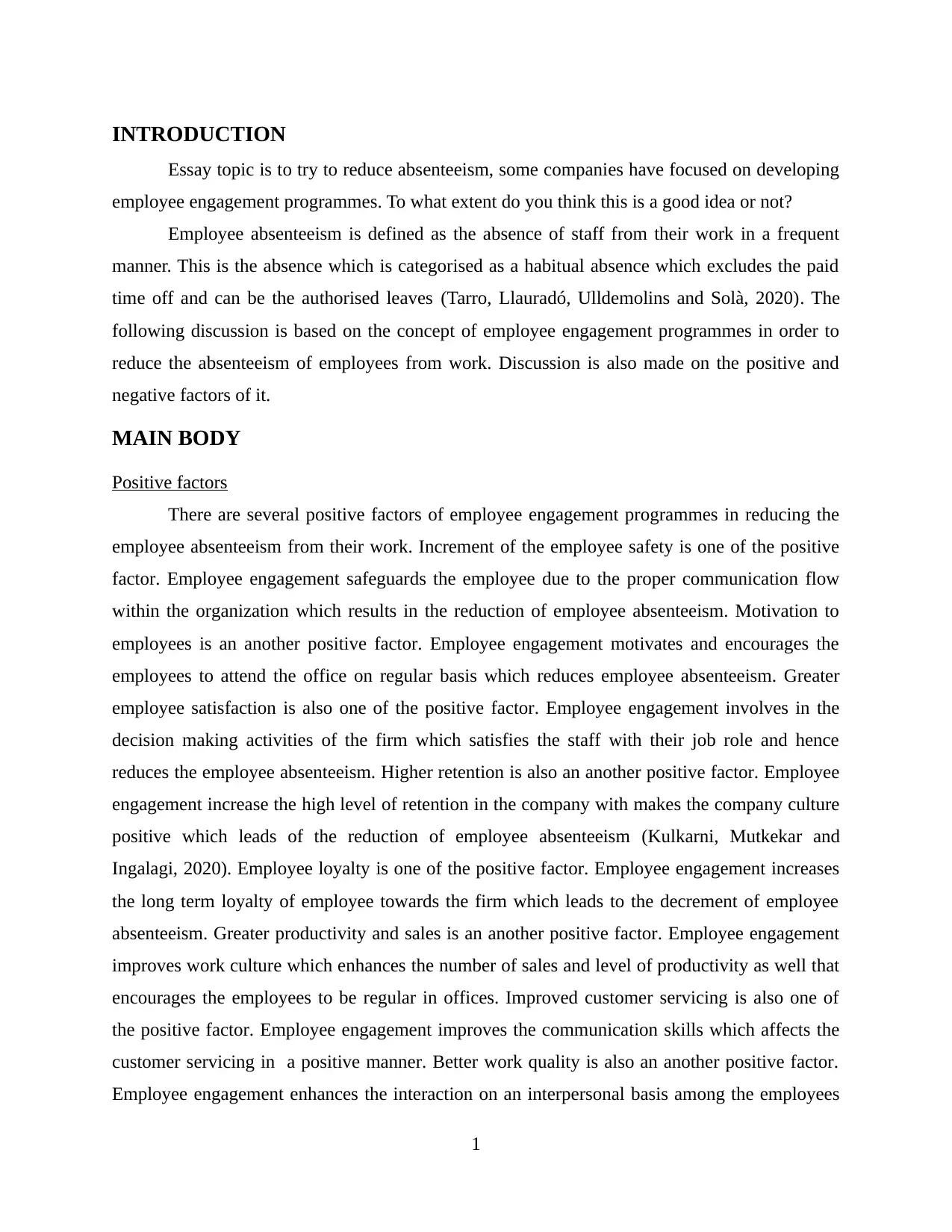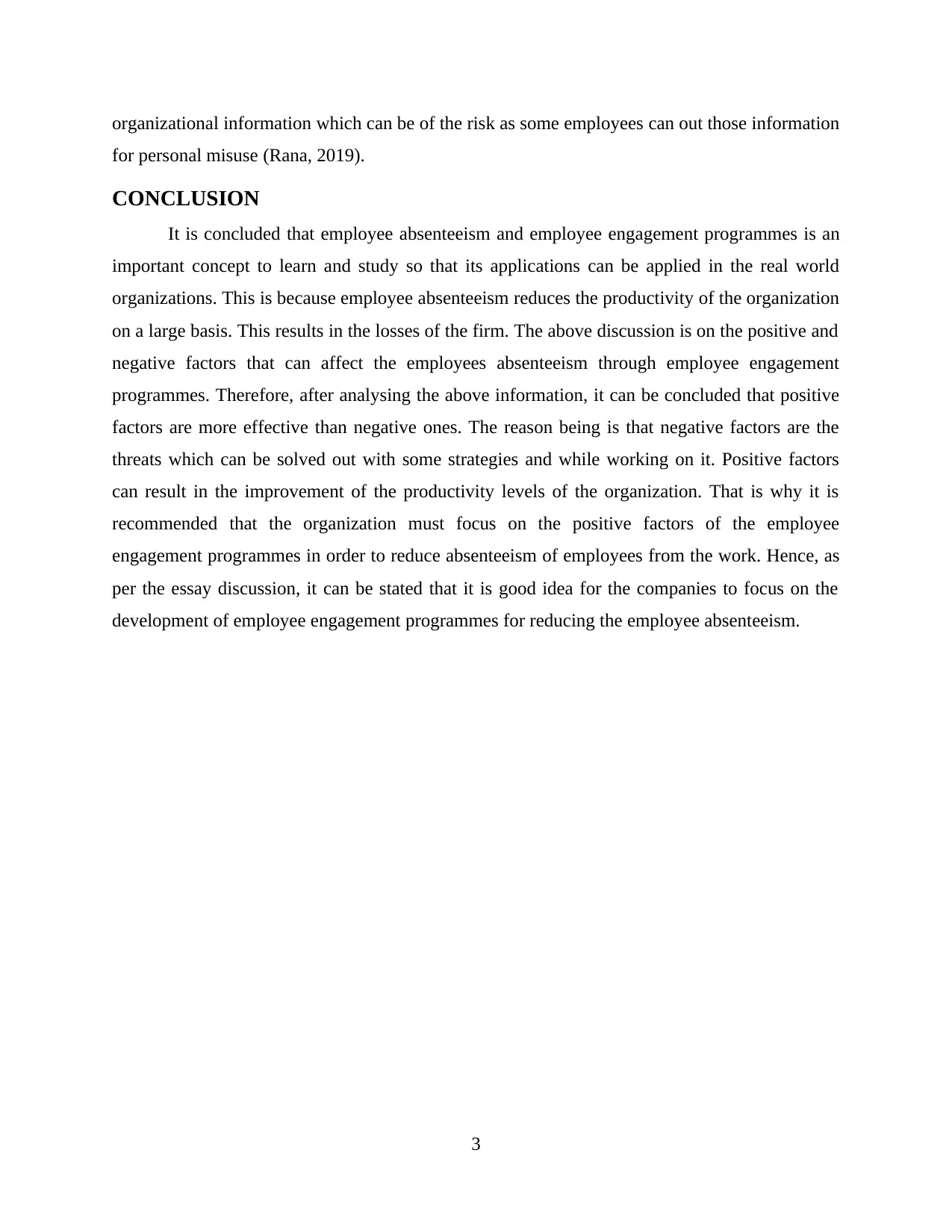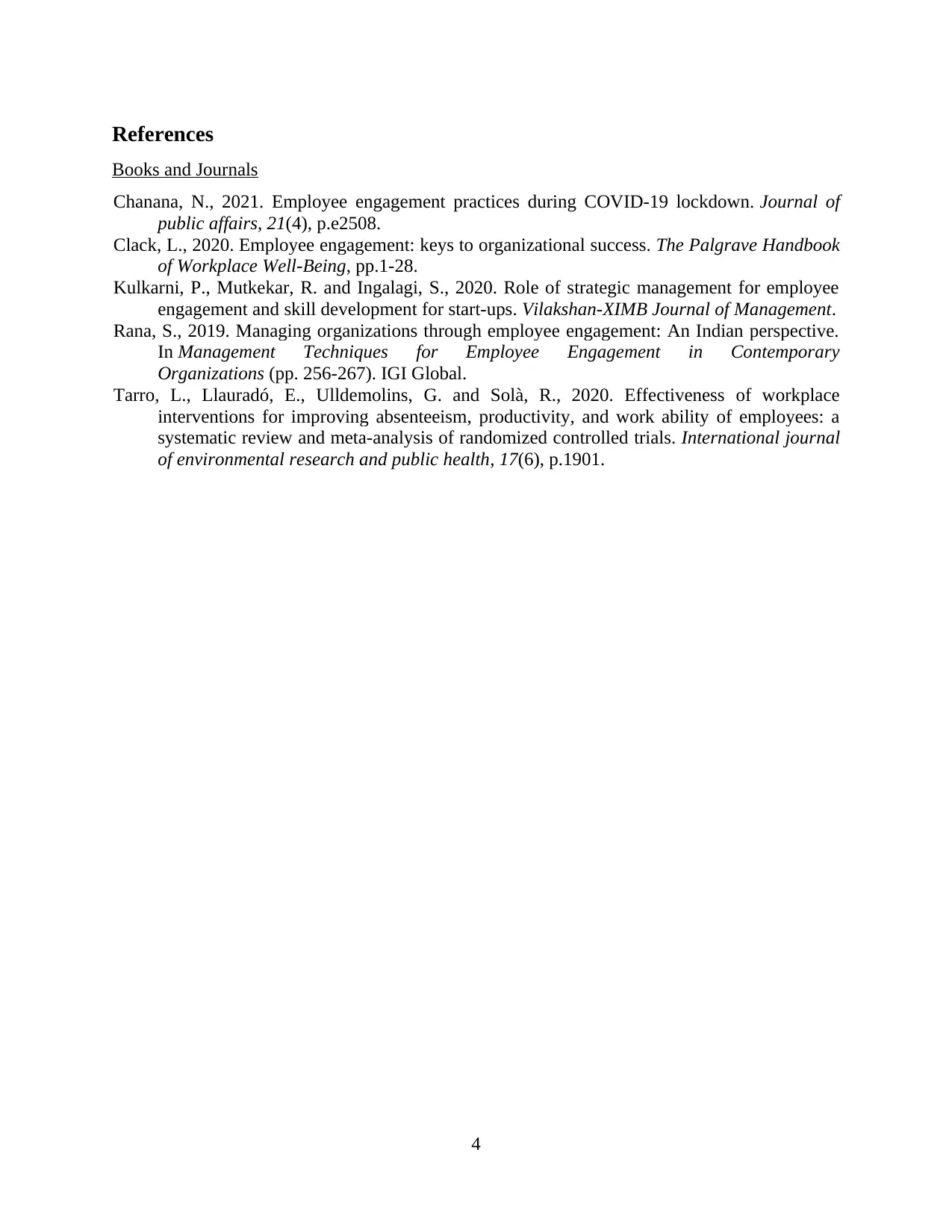Evaluating Employee Engagement Programs for Reducing Absenteeism
VerifiedAdded on 2023/06/12
|6
|1314
|212
Essay
AI Summary
This essay delves into the concept of utilizing employee engagement programs as a strategy to reduce employee absenteeism. It presents a balanced discussion, highlighting both the positive and negative factors associated with such programs. Positive aspects include increased employee safety, motivation, satisfaction, retention, loyalty, productivity, improved customer servicing, better work quality, a positive working environment, and enhanced innovation. Conversely, negative factors encompass the risk of employee burnout, less than full participation, overtime issues, lack of clarity, poor work-life balance, inefficient cost and time allocation, planning difficulties, diversity challenges, and security risks. The essay concludes that while negative factors pose threats, they can be mitigated with strategic planning, and the positive factors ultimately outweigh the negatives, leading to improved productivity and a more engaged workforce, thus recommending the focus on positive aspects to reduce absenteeism.

ESSAY
Paraphrase This Document
Need a fresh take? Get an instant paraphrase of this document with our AI Paraphraser

Table of Contents
INTRODUCTION...........................................................................................................................1
MAIN BODY...................................................................................................................................1
Positive factors.......................................................................................................................1
Negative factors......................................................................................................................2
CONCLUSION................................................................................................................................3
References........................................................................................................................................4
INTRODUCTION...........................................................................................................................1
MAIN BODY...................................................................................................................................1
Positive factors.......................................................................................................................1
Negative factors......................................................................................................................2
CONCLUSION................................................................................................................................3
References........................................................................................................................................4

INTRODUCTION
Essay topic is to try to reduce absenteeism, some companies have focused on developing
employee engagement programmes. To what extent do you think this is a good idea or not?
Employee absenteeism is defined as the absence of staff from their work in a frequent
manner. This is the absence which is categorised as a habitual absence which excludes the paid
time off and can be the authorised leaves (Tarro, Llauradó, Ulldemolins and Solà, 2020). The
following discussion is based on the concept of employee engagement programmes in order to
reduce the absenteeism of employees from work. Discussion is also made on the positive and
negative factors of it.
MAIN BODY
Positive factors
There are several positive factors of employee engagement programmes in reducing the
employee absenteeism from their work. Increment of the employee safety is one of the positive
factor. Employee engagement safeguards the employee due to the proper communication flow
within the organization which results in the reduction of employee absenteeism. Motivation to
employees is an another positive factor. Employee engagement motivates and encourages the
employees to attend the office on regular basis which reduces employee absenteeism. Greater
employee satisfaction is also one of the positive factor. Employee engagement involves in the
decision making activities of the firm which satisfies the staff with their job role and hence
reduces the employee absenteeism. Higher retention is also an another positive factor. Employee
engagement increase the high level of retention in the company with makes the company culture
positive which leads of the reduction of employee absenteeism (Kulkarni, Mutkekar and
Ingalagi, 2020). Employee loyalty is one of the positive factor. Employee engagement increases
the long term loyalty of employee towards the firm which leads to the decrement of employee
absenteeism. Greater productivity and sales is an another positive factor. Employee engagement
improves work culture which enhances the number of sales and level of productivity as well that
encourages the employees to be regular in offices. Improved customer servicing is also one of
the positive factor. Employee engagement improves the communication skills which affects the
customer servicing in a positive manner. Better work quality is also an another positive factor.
Employee engagement enhances the interaction on an interpersonal basis among the employees
1
Essay topic is to try to reduce absenteeism, some companies have focused on developing
employee engagement programmes. To what extent do you think this is a good idea or not?
Employee absenteeism is defined as the absence of staff from their work in a frequent
manner. This is the absence which is categorised as a habitual absence which excludes the paid
time off and can be the authorised leaves (Tarro, Llauradó, Ulldemolins and Solà, 2020). The
following discussion is based on the concept of employee engagement programmes in order to
reduce the absenteeism of employees from work. Discussion is also made on the positive and
negative factors of it.
MAIN BODY
Positive factors
There are several positive factors of employee engagement programmes in reducing the
employee absenteeism from their work. Increment of the employee safety is one of the positive
factor. Employee engagement safeguards the employee due to the proper communication flow
within the organization which results in the reduction of employee absenteeism. Motivation to
employees is an another positive factor. Employee engagement motivates and encourages the
employees to attend the office on regular basis which reduces employee absenteeism. Greater
employee satisfaction is also one of the positive factor. Employee engagement involves in the
decision making activities of the firm which satisfies the staff with their job role and hence
reduces the employee absenteeism. Higher retention is also an another positive factor. Employee
engagement increase the high level of retention in the company with makes the company culture
positive which leads of the reduction of employee absenteeism (Kulkarni, Mutkekar and
Ingalagi, 2020). Employee loyalty is one of the positive factor. Employee engagement increases
the long term loyalty of employee towards the firm which leads to the decrement of employee
absenteeism. Greater productivity and sales is an another positive factor. Employee engagement
improves work culture which enhances the number of sales and level of productivity as well that
encourages the employees to be regular in offices. Improved customer servicing is also one of
the positive factor. Employee engagement improves the communication skills which affects the
customer servicing in a positive manner. Better work quality is also an another positive factor.
Employee engagement enhances the interaction on an interpersonal basis among the employees
1
⊘ This is a preview!⊘
Do you want full access?
Subscribe today to unlock all pages.

Trusted by 1+ million students worldwide

which rather improves the quality of working that reduces the employee absenteeism. Positive
working environment is one of the positive factor. Employee engagement brings positivity in the
working culture with proper collaboration of work and working within the teams. Enhanced
innovation and ideas is an another positive factor. Employee engagement involves the
brainstorming process in which staff sits in a group and discussed about the problems and
solutions. This results in the new thoughts and also helps in reducing the absenteeism of
employees in an effective and efficient manner (Chanana, 2021).
Negative factors
There are several negative factors of employee engagement programmes in reducing the
employee absenteeism from their work. Pushing employees into burnout is one of the negative
factor. This is because pressurizing employees in terms of employee engagement can result in
the more of employee absenteeism which can lead to negative effects of employee engagement
programmes within organization. Less then 100% participation is an another negative factor.
This is because employee engagement is conducted for the employees if they will only not
participate then it will be highly difficult to reduce the absenteeism. Overtime of employees is
also one of the negative factor. This is because employee engagement activities are not
conducted in the working hours and therefore, employees face problems in giving overtime to to
such activities which results in employee absenteeism. Lack of clarity is also an another negative
factor. This is because there is a person who host such employee engagement activities, they
must be clear first before delivering the content and if they lack in this, it can result in the
employee absenteeism (Clack, 2020). Lack of work life balance is one of the negative factor.
This is because employee engagement consumes a lot of time through which employees are not
able to give proper time to their personal life as well as professional life. Inefficient cost and time
is an another negative factor. This is because employee engagement activities requires a lot of
time and cost to be spend which is expensive in nature. Planning the entire scenario is difficult is
also one of the negative factor. This is because employee engagement activities requires the high
feasibility studies which require the strategic planning so that the extra cost an time can be cut
off. Diversity is a problem is also an another negative factor. This is because employee
engagement is for the people who are mainly for the different culture, it is difficult to understand
the diversified culture which affects the employee absenteeism. Security risk is an another
negative factor. This is because employees engagement require the disclosing of some of the
2
working environment is one of the positive factor. Employee engagement brings positivity in the
working culture with proper collaboration of work and working within the teams. Enhanced
innovation and ideas is an another positive factor. Employee engagement involves the
brainstorming process in which staff sits in a group and discussed about the problems and
solutions. This results in the new thoughts and also helps in reducing the absenteeism of
employees in an effective and efficient manner (Chanana, 2021).
Negative factors
There are several negative factors of employee engagement programmes in reducing the
employee absenteeism from their work. Pushing employees into burnout is one of the negative
factor. This is because pressurizing employees in terms of employee engagement can result in
the more of employee absenteeism which can lead to negative effects of employee engagement
programmes within organization. Less then 100% participation is an another negative factor.
This is because employee engagement is conducted for the employees if they will only not
participate then it will be highly difficult to reduce the absenteeism. Overtime of employees is
also one of the negative factor. This is because employee engagement activities are not
conducted in the working hours and therefore, employees face problems in giving overtime to to
such activities which results in employee absenteeism. Lack of clarity is also an another negative
factor. This is because there is a person who host such employee engagement activities, they
must be clear first before delivering the content and if they lack in this, it can result in the
employee absenteeism (Clack, 2020). Lack of work life balance is one of the negative factor.
This is because employee engagement consumes a lot of time through which employees are not
able to give proper time to their personal life as well as professional life. Inefficient cost and time
is an another negative factor. This is because employee engagement activities requires a lot of
time and cost to be spend which is expensive in nature. Planning the entire scenario is difficult is
also one of the negative factor. This is because employee engagement activities requires the high
feasibility studies which require the strategic planning so that the extra cost an time can be cut
off. Diversity is a problem is also an another negative factor. This is because employee
engagement is for the people who are mainly for the different culture, it is difficult to understand
the diversified culture which affects the employee absenteeism. Security risk is an another
negative factor. This is because employees engagement require the disclosing of some of the
2
Paraphrase This Document
Need a fresh take? Get an instant paraphrase of this document with our AI Paraphraser

organizational information which can be of the risk as some employees can out those information
for personal misuse (Rana, 2019).
CONCLUSION
It is concluded that employee absenteeism and employee engagement programmes is an
important concept to learn and study so that its applications can be applied in the real world
organizations. This is because employee absenteeism reduces the productivity of the organization
on a large basis. This results in the losses of the firm. The above discussion is on the positive and
negative factors that can affect the employees absenteeism through employee engagement
programmes. Therefore, after analysing the above information, it can be concluded that positive
factors are more effective than negative ones. The reason being is that negative factors are the
threats which can be solved out with some strategies and while working on it. Positive factors
can result in the improvement of the productivity levels of the organization. That is why it is
recommended that the organization must focus on the positive factors of the employee
engagement programmes in order to reduce absenteeism of employees from the work. Hence, as
per the essay discussion, it can be stated that it is good idea for the companies to focus on the
development of employee engagement programmes for reducing the employee absenteeism.
3
for personal misuse (Rana, 2019).
CONCLUSION
It is concluded that employee absenteeism and employee engagement programmes is an
important concept to learn and study so that its applications can be applied in the real world
organizations. This is because employee absenteeism reduces the productivity of the organization
on a large basis. This results in the losses of the firm. The above discussion is on the positive and
negative factors that can affect the employees absenteeism through employee engagement
programmes. Therefore, after analysing the above information, it can be concluded that positive
factors are more effective than negative ones. The reason being is that negative factors are the
threats which can be solved out with some strategies and while working on it. Positive factors
can result in the improvement of the productivity levels of the organization. That is why it is
recommended that the organization must focus on the positive factors of the employee
engagement programmes in order to reduce absenteeism of employees from the work. Hence, as
per the essay discussion, it can be stated that it is good idea for the companies to focus on the
development of employee engagement programmes for reducing the employee absenteeism.
3

References
Books and Journals
Chanana, N., 2021. Employee engagement practices during COVID‐19 lockdown. Journal of
public affairs, 21(4), p.e2508.
Clack, L., 2020. Employee engagement: keys to organizational success. The Palgrave Handbook
of Workplace Well-Being, pp.1-28.
Kulkarni, P., Mutkekar, R. and Ingalagi, S., 2020. Role of strategic management for employee
engagement and skill development for start-ups. Vilakshan-XIMB Journal of Management.
Rana, S., 2019. Managing organizations through employee engagement: An Indian perspective.
In Management Techniques for Employee Engagement in Contemporary
Organizations (pp. 256-267). IGI Global.
Tarro, L., Llauradó, E., Ulldemolins, G. and Solà, R., 2020. Effectiveness of workplace
interventions for improving absenteeism, productivity, and work ability of employees: a
systematic review and meta-analysis of randomized controlled trials. International journal
of environmental research and public health, 17(6), p.1901.
4
Books and Journals
Chanana, N., 2021. Employee engagement practices during COVID‐19 lockdown. Journal of
public affairs, 21(4), p.e2508.
Clack, L., 2020. Employee engagement: keys to organizational success. The Palgrave Handbook
of Workplace Well-Being, pp.1-28.
Kulkarni, P., Mutkekar, R. and Ingalagi, S., 2020. Role of strategic management for employee
engagement and skill development for start-ups. Vilakshan-XIMB Journal of Management.
Rana, S., 2019. Managing organizations through employee engagement: An Indian perspective.
In Management Techniques for Employee Engagement in Contemporary
Organizations (pp. 256-267). IGI Global.
Tarro, L., Llauradó, E., Ulldemolins, G. and Solà, R., 2020. Effectiveness of workplace
interventions for improving absenteeism, productivity, and work ability of employees: a
systematic review and meta-analysis of randomized controlled trials. International journal
of environmental research and public health, 17(6), p.1901.
4
⊘ This is a preview!⊘
Do you want full access?
Subscribe today to unlock all pages.

Trusted by 1+ million students worldwide
1 out of 6
Related Documents
Your All-in-One AI-Powered Toolkit for Academic Success.
+13062052269
info@desklib.com
Available 24*7 on WhatsApp / Email
![[object Object]](/_next/static/media/star-bottom.7253800d.svg)
Unlock your academic potential
Copyright © 2020–2025 A2Z Services. All Rights Reserved. Developed and managed by ZUCOL.





